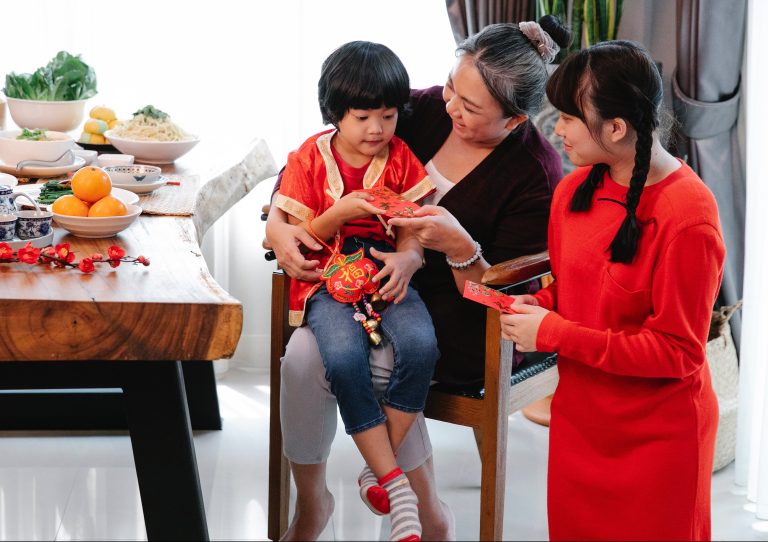In 2024, the Chinese New Year falls on Feb. 10. Millions of people will bid farewell to the yin water rabbit year and welcome the year of the yang wood dragon.
Out of all the animals in the Chinese zodiac, only the dragon (龍 lóng) is mythical, admired as a symbol of strength, power and wisdom. Those born in the Year of the Dragon — repeated every 12 years, with the last having been 2012 — are believed to have a charismatic personality, with a natural tendency to become brilliant, confident leaders.
Why does the Chinese New Year fall on different dates each year? How is it related to concepts such as the Chinese zodiac and the five elements?
Enjoy this beginner guide to the traditional Chinese calendar, as well as the customs and meanings of the Chinese New Year.
The traditional calendar and ancient Chinese cosmology
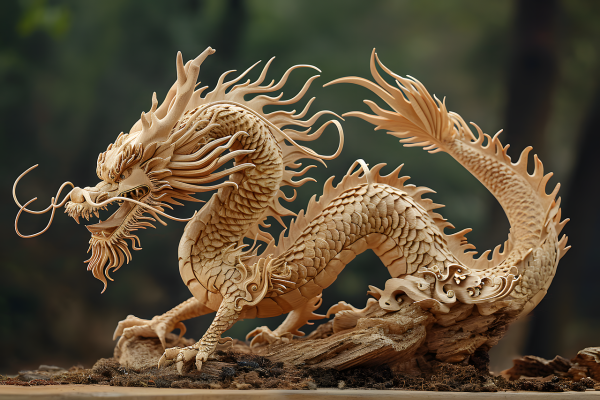
According to the ancient Chinese calendar, 2024, starting Feb. 10, is the year of jia chen (甲辰).
Success
You are now signed up for our newsletter
Success
Check your email to complete sign up
The Gregorian calendar used around the world today is a solar calendar, based on the 365-day period in which the earth makes a complete orbit around the sun.
In ancient China, however, people counted years and months in a system that accounted for both the lunar phases and the solar year.
Out of respect for the Yellow Emperor Xuanyuan (軒轅黃帝), the legendary founder of Chinese civilization, the lunisolar calendar is properly referred to as the huang li (黃曆) — the Yellow Emperor’s calendar. As his reign was said to have begun in 2698 B.C., the year 2024 is Year 4722 by the Chinese reckoning.
In practice, however, the Chinese counted years by the name of the era, established by the emperor or government, as is still done in Japan and Taiwan today.
Another important system was a 60-year cycle that resulted from the combination of two important concepts in Chinese cosmology and divination: the heavenly stems (天干 Tiān gān) and earthly branches (地支 Dì zhī).
There are 10 heavenly stems and 12 earthly branches, all arranged in a set order:
Heavenly stems: 甲乙丙丁戊己庚辛壬癸
Earthly branches: 子丑寅卯辰巳午未申酉戌亥
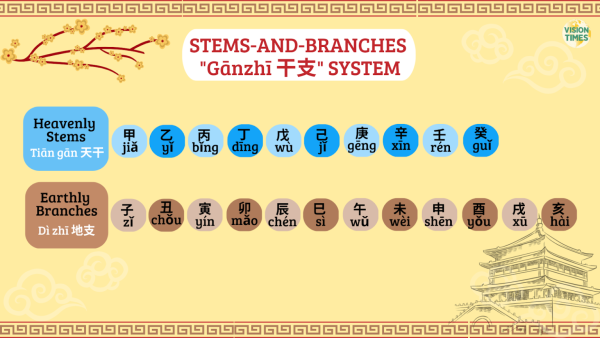
The two sets are combined to form unique pairs following their order. The first heavenly stem is paired up with the first earthly branch, and the second heavenly stem is paired up with the second earthly branch. Since there are more branches than stems, the first two stems are repeated to create the last two pairs.
The pairing of branches and stems keeps repeating until the last stem (癸 guǐ) and the last branch (亥 hài) come together. It takes 60 combinations for this to happen, and this is what gives rise to the 60-year cycle. Each stem-branch combination denotes and characterizes each year in the sexagenary cycle.
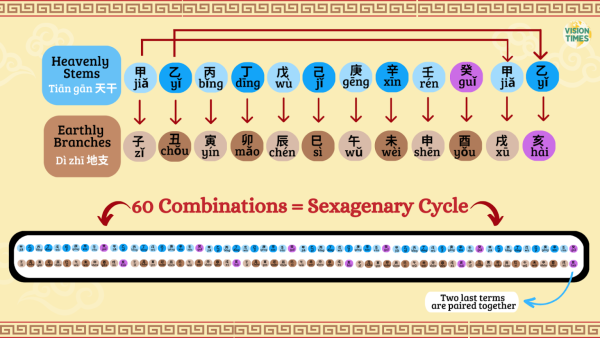
The year 2023 was the year 癸卯 (guǐ mǎo), the 40th year of the current sexagenary cycle. This year will be the year 甲辰 (jiǎ chén), with the last jia chen year having been 1964, exactly 60 years ago.
The Chinese zodiac and the five elements
In order to bring human life into harmony with the natural world and the cosmos, the Chinese established correspondences between the earthly branches and the zodiac, and between the celestial branches and the five elements.
The zodiac animals are paired with the earthly branches. In order, the zodiac animals and their associated branches are: 子, Rat; 丑, Ox; 寅, Tiger; 卯, Rabbit; 辰, Dragon; 巳, Snake; 午, Horse; 未, Sheep; 申, Monkey; 酉, Rooster; 戌, Dog; and 亥, Pig.
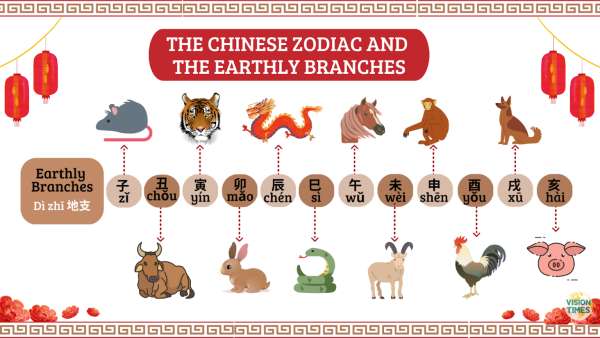
Each year is assigned the animal corresponding to the earthly branch of that year. The year 2023, gui mao, was recognized as the year of the rabbit due to its earthly branch mao 卯. Hence, 2024 corresponds to the dragon, for its earthly branch is 辰 (chén).
Since the 12 branches are cyclically repeated, each animal takes the spotlight every 12 years. Anyone with a dragon zodiac sign in recent history was born in years such as 1964, 1976, 1988, 2000, or 2012.
As for the heavenly stems, they correspond to the five elements (五行 wǔ xíng). Each element is assigned to two consecutive stems following the order of their generation. That is, wood (木 mù), fire (火 huǒ), earth (土 tǔ), metal (金 jīn), and water (水 shuǐ).
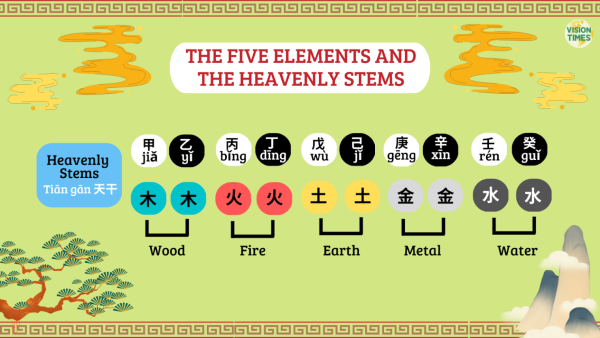
Each year is attributed an element depending on its heavenly stem. Since 2023 corresponded to the heavenly stem 癸 (guǐ), its element was water. Given that 2024 — year 甲辰 (jiǎ chén) in the sexagenary cycle — contains the first heavenly stem 甲, its element will be wood.
In addition, each heavenly stem and earthly branch is assigned a yin or yang attribute, with those in even positions always being yin. This means that a year that begins with the first stem — 甲 (jiǎ) — will always have yang properties, and a year that starts with 乙 (yǐ) will be considered yin in nature.
Properly said, 2023 was the year of the yin water rabbit, and 2024 will be the year of the yang wood dragon. Following these rules, can you predict the animal, element, and nature of 2025?
You got it! 2025 will be the year 乙巳 (yǐ sì), that is, the year of the yin wood snake.
Preparing for the new year
Traditionally, the Chinese took at least nine days to prepare for the New Year. Preparations ranged from cleaning the house to adjusting the mindset to start the year off on the right foot.
The ancient Chinese believed that cleaning the house would not only attract good fortune, but also sweep away bad luck. Although the custom of welcoming the new year in a clean home is common to many cultures, the Chinese made sure to sweep from the corners toward the center of the room, ultimately throwing bad luck out the back door.
Paper cuts are a staple of New Year’s decorations. Colorful paper is cut out following intricate designs that create a pattern as detailed as it is beautiful. These pieces are placed on doors or windows, the latter being preferred to reproduce the designs in shadows as the sun’s rays pass through the cutouts.

Another custom is to hang positive words and messages on and around doors and windows to attract blessings in the new year. In particular, the character 福 (fú) — meaning happiness, good luck and good fortune — decorates the entrances of most Chinese homes worldwide, usually displayed on diagonal red squares.
Interestingly, this character is hung upside down because the words “upside down” (倒 dào) and “arrive” (到 dào) are homophones in Chinese. In short, this tradition invokes the arrival of blessings.
Holding one’s temper was also part of the preparation for the New Year. The Chinese believed that one’s state of mind when receiving the new year would affect the following 12 months. Therefore, they refrained from swearing, losing their temper, and even scolding children for as long as they could, or at least during the 15 days of the New Year celebration.
Celebrating the New Year
Food
The varied and delicious food served at the New Year celebration is not chosen arbitrarily. Many of the dishes represent blessings through clever and auspicious Chinese wordplay.
A freshly-cooked whole fish is always on the table. This is because the word for “fish” in Chinese, 鱼 (yú), is a homophone of a word that means “surplus,” 余 (yú). The fish, however, should never be flipped over, lest your “surplus” becomes a deficit. Once the top has been eaten, the backbone is gently removed to continue eating the other half.
Dumplings are a must-have and are usually eaten on New Year’s eve after midnight. The crescent-shaped ravioli-like pockets resemble ancient Chinese silver or gold ingots, summoning prosperity for the new year.
Another essential for the New Year’s meal is rice cakes. Sweet or savory, these snacks are prepared with glutinous rice flour and have a sticky consistency. Their presence on the table is due to their Chinese name 年糕 (nián gāo), which is a homophone of 年高 (nián gāo), meaning literally “top year” or “grow every year.”
Firecrackers
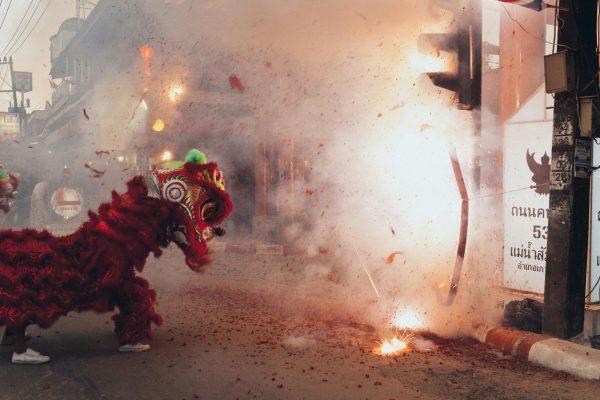
Firecrackers are left to explode on the street. An ancient type comes in the shape of red bright cylinders that make thunderous sounds when ignited.
The tradition has its origins in the legend of the Nian, a fearsome beast that came to terrorize villagers during the Shang Dynasty. Over time, people realized that the Nian only paid them a visit every 365 days, and that the imposing creature feared loud sounds.
Determined to keep their people safe, the villagers prepared lots of fireworks and lit them when the Nian was due to return. The beast never reappeared, cementing a tradition that endures to this day.
Cards and red envelopes
New Year’s morning is a long-awaited moment for most children. According to tradition, couples and grandparents prepare a decorative red envelope with money for those who are single – mainly the youngsters of the family.

Such a gift was believed to bring good luck to the recipient and protect them from evil. Instead of opening the envelopes on the spot, children were encouraged to sleep with them under their pillow for seven nights before opening them. The small but difficult wait would bring maximum fortune.
For the ancient Chinese, the most important part of the New Year celebration was to gather with family and, above all, to pay respects and express gratitude to divinity. May your new year be filled with blessings and opportunities for spiritual growth!



